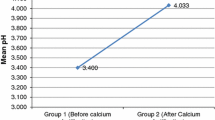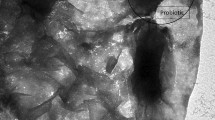Abstract
Aims
To evaluate the chemical characteristics of grape and orange juices, and their erosive potential in the decrease of microhardness and the loss of enamel structure.
Methods
Five grape and orange juices were evaluated for pH, titratable acidity, calcium, phosphate, and fluoride concentration. De-ionised water and Cola soft drink were used as a negative and positive control, respectively. Twelve specimens of bovine enamel were immersed in beverages for 10 min at 37 °C, 3 times/day for 7 days. Erosive potential was quantified using microhardness and loss of enamel structure. Anova One Way, Student’s t test, Multiple Regression and Spearman Correlation (p < 0.05) were used to analyse the results.
Results
Powdered grape juice showed the lowest pH (3.18 ± 0.03) and pure grape juice presented the highest titratable acidity (5.48 ± 0.06 mL NaOH/100 mL). Fresh orange juice and soya-based grape juice revealed the lowest calcium (0.77 ± 0.12 mmol/L) and phosphate concentrations (0.35 ± 0.06 mmol/L), respectively. Among juices, powdered orange juice caused the greatest decrease in surface microhardness (SMH) (127.99 ± 40.47 ΔSMH) and grape juice from concentrate caused the greatest loss of enamel structure (13.30 ± 3.56 μm).
Conclusions
All of the evaluated juices contributed to dental erosion. Grape juices presented greater erosive potential than orange juices. Pure, powdered and concentrated grape juices showed similar loss of enamel structure to the Cola soft drink. The erosive potential of beverages was statistically correlated to pH, titratable acidity, calcium, phosphate and fluoride concentrations.

Similar content being viewed by others
References
Abu-Ghazaleh SB, Burnside G, Milosevic A. The prevalence and associated risk factors for tooth wear and dental erosion in 15- to 16-year-old schoolchildren in Amman, Jordan. Eur Arch Paediatr Dent. 2013;14:21–7.
Borjian A, Ferrari CCF, Anouf A, Touyz LZG. Pop-cola acids and tooth erosion: an in vitro, in vivo, electron-microscopic, and clinical report. Int J Dent. 2010;2010:12p.
Brito JS, Neto A, Silva L, et al. Analysis of dental enamel surface submitted to fruit juice plus soymilk by micro X-ray fluorescence: in vitro study. Sci World J. 2016;2016:8.
Carvalho TS, Schmid TM, Baumann T, Lussi A. Erosive effect of different dietary substances on deciduous and permanent teeth. Clin Oral Invest. 2017;21:1519–26.
Chrysanthakopoulos NA. Prevalence of tooth erosion and associated factors in 13–16-years-old adolescents in Greece. J Clin Exp Dent. 2012;4:160–6.
Corrêa MSNP, Corrêa FNP, Corrêa JPNP, Murakami C, Mendes FM. Prevalence and associated factors of dental erosion in children and adolescents of a private dental practice. Int J Paediatr Dent. 2011;21:451–8.
Edwards M, Creanor SL, Foye RH, Gilmour WH. Buffering capacities of soft drinks: the potential influence on dental erosion. J Oral Rehab. 1999;26:923–7.
Ehlen LA, Marshall T, Qian F, Wefel JS, Warren JJ. Acidic beverages increase the risk of in vitro tooth erosion. Nutr Res. 2008;28:299–303.
Fujii M, Kitasako Y, Sadr A, Tagami J. Roughness and pH changes of enamel surface induced by soft drinks in vitro-applications of stylus profilometry, focus variation 3D scanning microscopy and micro pH sensor. Dent Mater J. 2011;30:404–10.
Gonçalves GKM, Guglielmi CAB, Corrêa FNP, Raggio DP, Corrêa MSNP. Erosive potential of different types of grape juices. Braz Oral Res. 2012;26:457–63.
Hannig C, Hamkens A, Becker K, Attin R, Attin T. Erosive effects of different acids on bovine enamel: release of calcium and phosphate in vitro. Arch Oral Biol. 2005;50:541–52.
Hughes JA, West NX, Parker DM, van den Braak MH, Addy M. Effects of pH and concentration of citric, malic and lactic acids on enamel, in vitro. J Dent. 2000;28:147–52.
Imfeld T. Dental erosion. Definition, classification and links. Eur J Oral Sci. 1996;104:151–5.
Jensdottir T, Bardow A, Holbrook P. Properties and modification of soft drinks in relation to their erosive potential in vitro. J Dent. 2005;33:569–75.
Jensdottir T, Holbrook P, Nauntofte B, Buchwald C, Bardow A. Immediate erosive potential of cola drinks and orange juices. J Dent Res. 2006;85:226–30.
Kitasako Y, Sasaki Y, Takagaki T. Age-specific prevalence of erosive tooth wear by acidic diet and gastroesophageal reflux in Japan. J Dent. 2015;43:418–23.
Kumar S, Acharya S, Mishra P, Debnath N, Vasthare R. Prevalence and risk factors for dental erosion among 11- to 14-year-old school children in South India. J Oral Sci. 2013;55:329–36.
Larsen MJ, Nyvad B. Enamel erosion by some soft drinks and orange juices relative to their ph, buffering effect and contents of calcium phosphate. Caries Res. 1999;33:81–7.
Lussi A, Jäggi T, Schärer S. The influence of different factors on in vitro enamel erosion. Caries Res. 1993;27:387–93.
Lussi A, Jaeggi T, Jaeggi-Schärer S. Prediction of the erosive potential of some beverages. Caries Res. 1995;29:349–54.
Lussi A, Megert B, Shellis RP, Wang X. Analysis of the erosive effect of different dietary substances and medications. Br J Nutr. 2012;107:252–62.
Mantonanaki M, Koletsi-Kounari H, Mamai-Homata E, Papaioannou W. Dental erosion prevalence and associated risk indicators among preschool children in Athens, Greece. Clin Oral Invest. 2013;17:585–93.
Murakami C, Oliveira LB, Sheiham A, et al. Risk indicators for erosive tooth wear in Brazilian preschool children. Caries Res. 2011;45:121–9.
Nayak SS, Ashokkumar BR, Ankola AV, Hebbal MI. Association of erosion with dietary factors among 5-year-old children in India. J Dent Child. 2012;79:122–9.
Okunseri C, Okunseri E, Gonzalez C, Visotcky A, Szabo A. Erosive tooth wear and consumption of beverages among children in the United States. Caries Res. 2011;45:130–5.
Sales-Peres SHC, Magalhães AC, Machado MAAM, Buzalaf MAR. Evaluation of the erosive potential of soft drinks. Eur J Dent. 2007;1:10–3.
Söderholm KJ, Mukherjee R, Longmate J. Filler leachability of composites stored in distilled water or artificial saliva. J Dent Res. 1996;75:1692–9.
West NX, Hughes JA, Addy M. Erosion of dentine and enamel in vitro by dietary acids: the effect of temperature, acid character, concentration and exposure time. J Oral Rehab. 2000;27:875–80.
Zhang S, Chau AMH, Lo ECM, Chu CH. Dental caries and erosion status of 12-year-old Hong Kong children. BMC Public Health. 2014;14:7.
Author information
Authors and Affiliations
Corresponding author
Ethics declarations
Conflict of interest
Beltrame APCA declares that she has no conflict of interest. Noschang RAT declares that he has no conflict of interest. Lacerda DP declares that she has no conflict of interest. Souza LC declares that she has no conflict of interest. Almeida ICS declares that she has no conflict of interest.
Ethical approval
This article does not contain any studies with human participants or animals performed by any of the authors.
Rights and permissions
About this article
Cite this article
Beltrame, A.P.C.A., Noschang, R.A.T., Lacerda, D.P. et al. Are grape juices more erosive than orange juices?. Eur Arch Paediatr Dent 18, 263–270 (2017). https://doi.org/10.1007/s40368-017-0296-6
Received:
Accepted:
Published:
Issue Date:
DOI: https://doi.org/10.1007/s40368-017-0296-6




